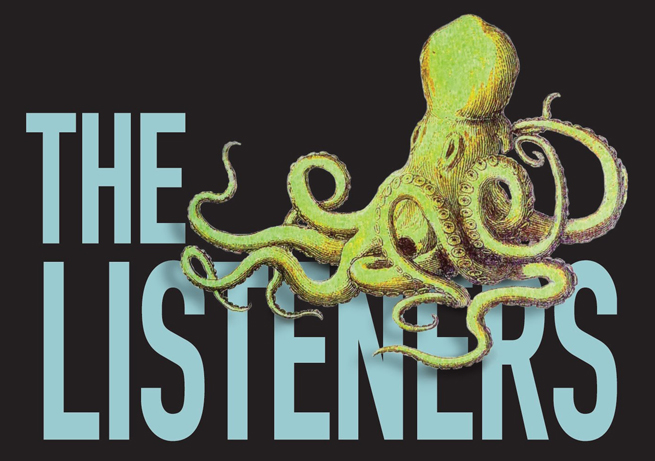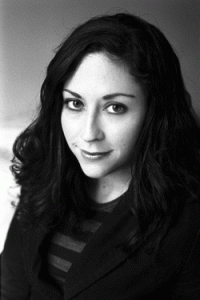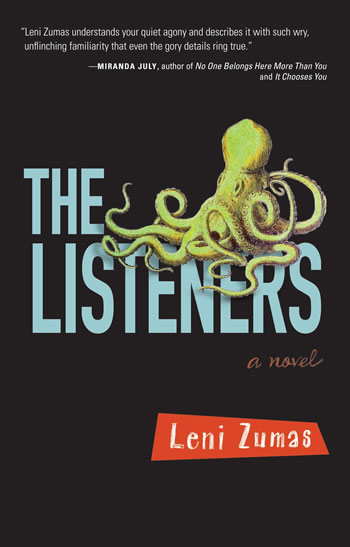Craft
A Complicated Business:
Leni Zumas, Listening, and The Listeners

 eni Zumas is the author of the story collection Farewell Navigator and the new novel The Listeners, about which Sam Lipsyte commented, “Just listen to The Listeners. You'll hear the prose of one of our most exciting young writers. Zumas has already proven herself a remarkable maker of short stories. Now she has sustained and heightened the exhilaration of her writing in this striking novel.” As in her stories, Zumas approaches representations of consciousness and reality in striking ways in The Listeners, a novel that moves tapestry-like through time and perception as we follow Quinn, a thirtysomething woman struggling with creative frustration and the ghosts of a family tragedy. We chatted with Zumas about titles, music, writing as a woman in the culture of “the workshop,” and what happens when a writer changes over the course of writing a novel.
eni Zumas is the author of the story collection Farewell Navigator and the new novel The Listeners, about which Sam Lipsyte commented, “Just listen to The Listeners. You'll hear the prose of one of our most exciting young writers. Zumas has already proven herself a remarkable maker of short stories. Now she has sustained and heightened the exhilaration of her writing in this striking novel.” As in her stories, Zumas approaches representations of consciousness and reality in striking ways in The Listeners, a novel that moves tapestry-like through time and perception as we follow Quinn, a thirtysomething woman struggling with creative frustration and the ghosts of a family tragedy. We chatted with Zumas about titles, music, writing as a woman in the culture of “the workshop,” and what happens when a writer changes over the course of writing a novel.
PROPELLER: I’d like to start off by asking about the novel’s title. Quinn, the novel’s main character, used to be in a band, and some of the novel’s material covers events that occur during that time. In the sections that show us Quinn while she’s in the band, then, we’re experiencing things with “the players.” It struck me that the title might refer to more than one aspect of the novel, though. How did you settle on the “The Listeners”? Did you have that from the beginning, or did it come about later? What kind of resonances does the title carry for you?
LENI ZUMAS: Titles are hard for me. I often experience title envy when I come across a book whose name is arresting and tuneful without being reductive or insistent. I struggled a lot to choose a title for this book. For a long time, the working name was “The Size of Curious,” referring to a game of questions Quinn plays with her siblings; then it became “Fingers and Names,” which I sort of liked (particularly as the words could operate as a noun pair or a verb phrase) but also found slightly repellent.
I thought of “The Listeners” when I was lying on an acupuncture table in Asheville, North Carolina. I’d been running through single words that carried some kind of weight in the novel—prevalent themes, images, actions—and “listen” was among them. The act of listening is important on a few different fronts: certainly in terms of music, as the narrator not only used to be a singer but came of age going to rock shows; and in terms of family, memory, and ghosts. Quinn listens for—and sometimes hears—the voice of her long-dead sister. Also, she suffers from tinnitus (after countless band practices and performances without earplugs) and she is synesthetic, so sounds and images get harnessed together in her brain. Listening, for Quinn, is a complicated business.
PROPELLER: Like Quinn, you’ve been in bands. How did you shift from music to fiction? What aspects of playing music can fiction never approximate? Are there expressive possibilities in fiction that music can’t realize?
 LENI ZUMAS: I’ve wanted to be a writer since I was seven years old, and I didn’t learn the drums until I was in college. Playing music never managed to thrill me the way writing and reading do, even though it was hugely important in my life for many years. Being in bands was always, for me, very much a social act, a way to be with other people, whereas writing is solitary. (The writing business isn’t, of course—we give readings, talk to other writers, attend literary cocktail parties—but the biz part is about a million times less important than what a writer does alone with her page.) The energy and excitement a musician shares with bandmates—that collective delirium—isn’t available to writers, and I miss it sometimes, but the missing is more nostalgia than serious ache.
LENI ZUMAS: I’ve wanted to be a writer since I was seven years old, and I didn’t learn the drums until I was in college. Playing music never managed to thrill me the way writing and reading do, even though it was hugely important in my life for many years. Being in bands was always, for me, very much a social act, a way to be with other people, whereas writing is solitary. (The writing business isn’t, of course—we give readings, talk to other writers, attend literary cocktail parties—but the biz part is about a million times less important than what a writer does alone with her page.) The energy and excitement a musician shares with bandmates—that collective delirium—isn’t available to writers, and I miss it sometimes, but the missing is more nostalgia than serious ache.
A story does so many things that a song can’t—and vice versa—that I’m not sure I can do justice to your question about their different expressive possibilities. But it’s interesting to notice what good fiction and good music share: an alertness to rhythm, cadence, repetition, intervals, acoustics. The sound of sentences is something I pay a lot of attention to, both as a writer and as a reader. Take this line from James Agee’s A Death in the Family: “Now is the night one blue dew.” The music of it completely drives the sentence!—the way we’re forced to wait, to be patient, even though the words themselves are all just one syllable long. Reminds me of something Virginia Woolf wrote in a letter: “Style is a very simple matter. It is all rhythm.”
PROPELLER: You mention that Quinn has tinnitis and is synesthetic, but she’s even more complex than that—she has a complicated relationship to food, too. I admired the way you handled that aspect of her experience of life, because her issues with food aren’t easily reducible to one term or root cause. Were there particular writing challenges to capturing Quinn's experience of the table—of both her eating and of others’—in words? I experience so much of my response to food as immediate reactions of taste and scent—almost non-linguistic. But you capture those moments very well in language that doesn’t seem easy or stale.
LENI ZUMAS: Quinn’s periodic self-starving springs from her fear of blood. Unlike the stereotypical anorexic, who starves in order to be thin, Quinn stops eating so she won’t get her period—she associates the red stuff with her sister’s death. You’re right to say that her food issues aren’t easily traceable to a single cause, but certainly she’s motivated by different manias than the desire to be skinny.
Writing about a female character’s relationship to food can be tricky: there are many holes of cliché to fall into, and many limiting assumptions a reader can bring to the work. I remember a workshop in graduate school where a fellow student (male) criticized my short story thus: “I just don’t want to hear about some fat chick stuffing doughnuts into her face.” A few other students nodded, and the male instructor let the comment slide by, unquestioned. Nobody pressed the student to go beyond “not feeling like it.” It was as if body image anxieties and compulsive eating were naturally repellent subject matter. As if girls and women who have trouble with food were easy to dismiss. This kind of prejudice shouldn’t keep us from writing about food issues, of course—but we may have to be extra-innovative in our representations.
When I was working on The Listeners, the figure of the bloodworm gave me a “way into” Quinn’s experience of eating. The worm’s oddness allowed me to depict her food aversion in a way I hoped would be less familiar, more intriguing, more visceral.PROPELLER: Readers who haven’t yet picked up the book are now saying, “The ‘figure of the bloodworm?’ What?” Could you say a bit more about the bloodworm? Not necessarily in a giving-away-story way, but maybe just by explaining what you mean when you say the bloodworm allowed you a way into Quinn’s experience. It’s a creature Quinn thinks about that lives in the territory between metaphorical thinking, magical thinking, and a kind of bodily ideation, right? Is that a fair way for me to describe it, or did you think about it differently?
LENI ZUMAS: The worm starts visiting Quinn after the violent accidental death of her sister. This creature is an eyeless blood-eater, always sniffing for fresh blood, and its appetite frightens Quinn into restricting food so she won’t get her period. Your description is accurate, I think: the creature occupies a “territory between,” that paper-thin threshold between the actual suffering body (Quinn’s murdered sister) and the image/memory/idea of the suffering body. For Quinn, the bloodworm feels as real as anything she can touch or see; for the reader, it’s a gory symbol.
 Maybe not every reader understands it as a symbol, however—I once had a woman at a reading ask me if I’d ever had a bloodworm in my body. She must have been equating it with ringworm or tapeworm? I said no, and she said indignantly, “How can you write about it if you never experienced it?” I don’t remember what I answered, but if I had to answer today, I would say that one of the pleasures of writing fiction is that we can travel—with empathy and curiosity—into experiences we’ve never had, mining our own disquiet and knowledge and sense-memories, looking for language that feels true. The bloodworm was my way of representing Quinn’s trauma as honestly as possible.
Maybe not every reader understands it as a symbol, however—I once had a woman at a reading ask me if I’d ever had a bloodworm in my body. She must have been equating it with ringworm or tapeworm? I said no, and she said indignantly, “How can you write about it if you never experienced it?” I don’t remember what I answered, but if I had to answer today, I would say that one of the pleasures of writing fiction is that we can travel—with empathy and curiosity—into experiences we’ve never had, mining our own disquiet and knowledge and sense-memories, looking for language that feels true. The bloodworm was my way of representing Quinn’s trauma as honestly as possible.
PROPELLER: I hear writers talk about novels as being something you have “to figure out” more than I hear them use that term about almost any other form of writing. Was there anything about turning this piece of fiction into “a novel” that was particularly challenging for you to figure out? And how did you resolve it?
LENI ZUMAS: One of the challenges was simply endurance. It took me several years to finish The Listeners and during that time I kept changing as a writer; the person who wrote the book’s last page was not exactly the same person who wrote its first. Some of the decisions I made early on would come to seem foolish or naïve or just wrong. It’s a confusing thing to work on a single project over many different years, through different phases in one’s life.
Another hurdle, for me, was creating narrative coherence out of a bunch of fragments. I didn’t write the book in sequence; I cobbled it together, jumping from one time-frame or thematic strand to another without worrying about the bigger picture. This piece-by-piece assemblage felt true to the novel’s logic—its particular way of imagining the world—but it made me a little crazy when it came time to decide where everything should go. In the end, I relied a lot on my future readers’ active participation in the text, their willingness to make connections among divergent splinters of story without much help from transitions or chronological order.
PROPELLER: It’s interesting to me that you mention “the novel's logic” but then also that making the assemblage decisions made you feel a little crazy—I guess just because the terms seem to suggest contradictory states. We tend to associate logic with order, and craziness with disorder. Could you say a bit more about what you mean by “the novel's logic,” and how a novel’s logic could make the novel’s own creator feel a little crazy?
LENI ZUMAS: As I was writing it, I pictured the novel as a constellation, a sky of stars, with every star standing for a major incident or question in the book. Raying out from each star were the consequences of (and precursors to) an event; the symptoms of a character’s central anxiety; or different characters’ perspectives on a single incident. For example, there’s a car crash in the book, and I wrote 25 different versions of the crash, from various characters’ POV and from a range of time registers—during, immediately after, ten years after, etc.
This “constellated” form was more faithful to Quinn’s vision of the world, because her past intrudes so relentlessly into her present that I couldn’t narrate her experience in chronological order. Which presented a problem, of course, when it came time to decide on a chapter sequence. I saw links among the stars—proximities, associations—but no straight line they could all sit on. I needed that line, because the reader would experience the book page by page; it wasn’t, for instance, going to be a hypertext novel where the reader could choose her own path through it. So that’s how the book’s form could seem entirely logical yet also drive me bonkers.
 PROPELLER: When you say that the Leni Zumas who finished writing the book was not the same as the one who started it, I’m sure some of that is personal—anyone changes as a person over eight years—but I assume much is aesthetic. How did you change as a writer over those years?
PROPELLER: When you say that the Leni Zumas who finished writing the book was not the same as the one who started it, I’m sure some of that is personal—anyone changes as a person over eight years—but I assume much is aesthetic. How did you change as a writer over those years?
LENI ZUMAS: I think I got better at noticing my own tics—the tendencies I was leaning on too heavily. For instance: overstating and re-stating. I would describe a thing once, then describe it again immediately, for no good reason. I love the effect appositive phrases can have—that surge of amending, of re-seeing, of perforating the certainty of what you’ve just claimed. But the device can be overdone; at least, I was overdoing in early drafts of The Listeners. So I started catching the excess and trying to rein it in.
Another issue was my attachment to characters and storylines, and how important it was for me to loosen this attachment as I went along. The novel started out with many more plot threads and characters than it finished with. I am somewhat embarrassed to admit that there was, early on, a detection/mystery subplot: a reporter with a chip on his shoulder was convinced that something had been rotten in Denmark when the band’s van crashed—some kind of criminal cover-up—and he was harassing Quinn as part of his investigation. That story arc, with its solve-the-mystery propulsion, was in some ways helpful to me in figuring out the bigger picture of the book; but it wasn’t necessary, and it kept creating a lot of awkwardness. Ditching the reporter character was a huge relief.
PROPELLER: So you’ve now published a collection of stories and a novel. Do you have a sense of which form you’ll work in on your next project? Do you conceive of a defined project and then work toward finishing that project specifically, or do you make decisions about your fiction writing in a different way?
 Leni Zumas lives in Portland, Oregon.
Leni Zumas lives in Portland, Oregon.


